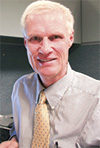At a recent training event at the USDA-NRCS State Office in East Lansing, Michigan, 25 employees attended a technical course for two days. I helped deliver this course. When done, I was drawn to write a commentary about the course’s students. Here is it in this column.
A technical course is based in science and uses numbers to define measurement including state and flux or rate of change (gradient). Much of science is discovering what already exists with instruments that measure a static point in time and then later, another point in time.
We live in three-dimensional space described as x and y, or planimetry, and then z as depth or vertical to the plane. We add time as the fourth dimension. For instance, a soil fertility analysis is based upon a field soil sample taken at some location on the field surface (x and y grid), at some depth (z, vertical) on a specific date and time.
The soil sample is dried, sent to the laboratory, exposed to an extractant with the labile nutrients desorbed from the mineral surface and then measured in an instrument. If the technician samples the same field at the same spot at the same depth six months later, we have a flux gradient between two points.
We also know there are infinitesimal static points between these six months, therefore providing the integral of rate of change. Such an integral as a part of calculus tells us the range or degree of change around the state line flux between two time periods, so let us use April 1 and October 1 for the reference year.
We may apply this integral model to soil moisture condition or ambient air temperature – or any one of other countless state fluxes that exist in what we call the stochastic environment of unbounded inputs and outputs.
We also can define the quality of data in the form of metadata, which provides the technician with an understanding of accuracy and error in each measurement. All scientific measurements have metadata, and all of them have some error of accuracy.
Finally, the scientific community knows that by adding complexity to any system, the data interactions require defining that may or may not be measurable with a state or flux measurement.
We may cognitively infer or deduce by logic the mechanisms of interactions, or some of us may use induction, which supposes certain outcomes are based on observation and experience. The cognitive deduction approach is based on already-known mechanisms, and from these, interactions are explained.
Induction, however, is built upon an exploratory methodology of insight, divergent principles and the disjoint of systems that may seem different to the extent they are apart from one another.
Written another way, deduction is a system of reductionism, taking what we know about a system or set of systems and reducing them to a single state point or flux gradient. Induction is systems-driven, and therefore, holistic as we attempt to explain interactions of individual components.
Using our crop field model, we know that soil fertility is one system, and volumetric water content is another. Both exist in the same four-dimensional space and time.
One technician may approach the model by explaining the interaction, deductively, by trying to use reductionism for each system individually and then combining them using a common language of each system.
And, of course, the crop field has many additional interactions of air temperature, rainfall, biomass growth, and so on. Each of these are systems that, taken together, make up a unified model that is not at all mechanistic but stochastic given the unbound inputs into and out of the entire unified system.
Here is my point.
Delivering technical training is hard work, especially if we are tasked with thinking about and explaining complex systems. A cropfield is just that. Our students easily understood the state and flux material for each of the individual systems.
In this case, the delivery of soil fertility was largely a chemical one, with a little bit of discussion about the physical (e.g. texture and moist bulk density) and the biological (e.g. soil organic matter decomposition and soil biota).
We added a discussion about another plant input: water. As you know, I often describe my own training as centered on the systems approach of the SPAC: the soil-plant-atmosphere-continuum. The common linkage of these three very different systems is water, as in transpiration and evaporation in both state time and flux time as a gradient.
The students had a much harder time understanding the SPAC, for to do so, they must use a more inductive approach. Individual systems are understood using deduction; a complex system requires a more inductive approach.
There are exceptions. But my premise is: Bringing knowledge to disjoint systems or combining discontinuities requires insight and experience, the “stuff” of induction.
We cannot train people to think inductively as easily as we can use cognitive thought to deduce knowledge. For instance, teaching soil fertility is rather straightforward; teaching the concepts of the SPAC, that is the integration of three different systems so that we understand something about their interactions, is much more challenging.
I often find many people with splendid training are reductionists. They are well-versed in the state and flux measurements of their specific system of interest, and they can interpret and evaluate these data with clarity.
The systems thinkers, however, must use a different set of skills to understand complex, or let me use the word multiple, systems that occupy the same space and time. Systems thinkers, such as myself, are truly “thinkers,” as we do not have the luxury of using only cognitive thinking in a deductive manner.
We must figure out how to manage disjointed or disconnected data into a working synthesis of knowledge that is based on insight, and really, empirical observation.
Farmers are fundamentally inductive thinkers. Every farmer that walks a cropfield does so looking at (empirical) multiple systems (e.g. the soil, the moisture in that soil, the air temperature, the wind, the crop biomass, the condition of the biomass, the field variability, and so on).
The farmer reconciles the cropfield by combining insight and experience that, in my opinion, no scientific instrument can measure. Yes, the scientific instrument can measure a particular component, such as soil temperature, leaf area index or solar radiation, but each of these examples is one measurement of each of the SPAC components.
How they interact together is the realm of induction, and in this cropfield, the farmer understands how to combine these systems into a unified interpretation.
Our students, for the most part, do not have this systems approach because nearly all of them lack field experience. Nearly all are not from farms. So we deliver a reductionist approach at learning, based on cognitive skills and deduction.
With time, they will begin putting these systems together. With time, they gain insight and knowledge based upon what they see by empirical observation.
One concern is allocating time to be in the field and not sitting behind the computer screen. During our field visits with landowners, for whatever reason, I always encourage the younger employees to ride along with us.
Sometimes the pushback comes from the supervisor making the case there is work to do in the office and he or she cannot ride along. Nonsense, there is no better place to be than with us, learning as we do our work and engage with the landowner.
May I offer this to you? The very next time you visit your USDA service center, and a field visit is scheduled on your farm at some point in the future, let the supervisor know that his younger staff members are more than welcome to come along as well.
And when they arrive, help them understand why the best learning environment is not in Conference Room B at the USDA-NRCS State Office in East Lansing … it is in the field, the field, the field. PD

Mike Gangwer
Agricultural Scientist
USDA-NRCS






